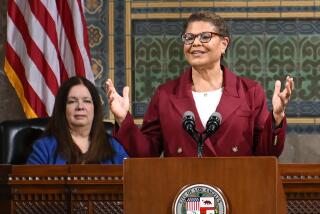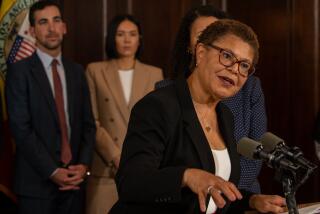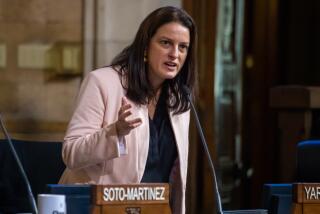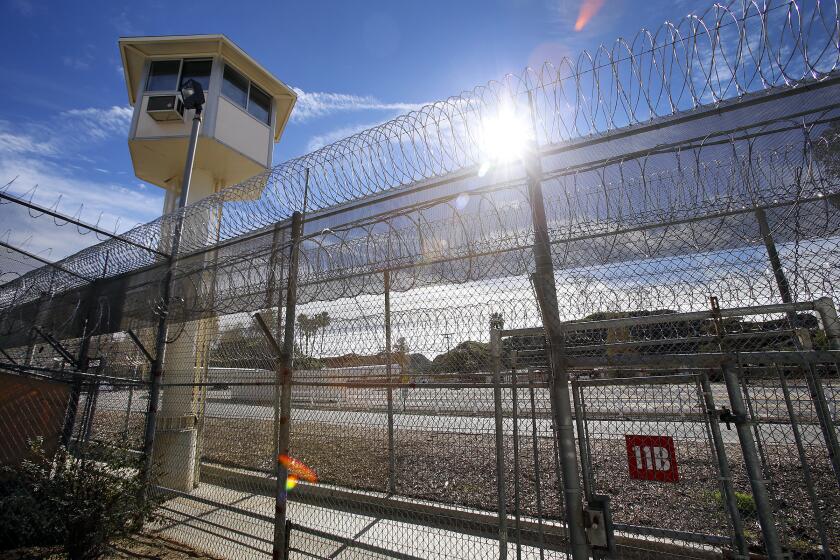$9.3-Million Drug Plan Wins OK : City Council: More foot patrols, expanded recreation center hours tentatively approved as part of $1.16-billion budget for fiscal 1992.
- Share via
The San Diego City Council has tentatively approved more police foot patrols, expanded recreation center hours and buying a third mobile police substation as part of a $9.3-million anti-drug program that highlights a $1.16-billion budget for fiscal 1992.
The budget, scheduled to be completed Monday and formally adopted by the council July 22, calls for substantial spending of Proposition 111 gas tax funds to speed sidewalk repair and street resurfacing, augment tree-trimming and maintain street lights and traffic signals.
With the expenditure of $2.5 million, the city also is scheduled to open a 200-bed pre-arraignment jail for misdemeanor arrestees early next year.
The budget also includes a sharp annual tax increase for large businesses and professional firms that will offset a tax cut for small businesses, and a sharp reduction in the Planning Department budget that is likely to produce layoffs.
“Primarily, we tried to keep what we had going and enhance where we could,” said Pat Frazier, the city’s director of financial management.
If approved unchanged from Thursday’s tentative spending plan, the budget for the fiscal year that begins Monday will actually be $79 million less than the current spending blueprint because expensive capital projects are being postponed.
But the city’s general fund, which pays for day-to-day operations, will rise 5.16%--or $23.5 million--to $478.6 million. On average, city employee salaries will increase 2%.
The council agreed to fund $9.3 million of a proposed $28.4-million Neighborhood Pride and Protection Plan, a wide-ranging effort to combat civic problems associated with drug use through additional law enforcement and prevention efforts.
In addition to the new jail, which Police Chief Bob Burgreen has called his top priority, the city will spend $2.4 million for 25 new foot patrol officers in communities hard-hit by drug use and sales.
The council also funded expanded recreation center hours, library hours and after-school recreation programs. It added money to introduce an anti-drug education program into junior and middle schools and created “homework centers,” where youths can study and use computers in city libraries.
The tax on small businesses was rolled back after owners complained about the sharp increase approved by the council last year--and a substantial number refused to pay it. Beginning later in the fiscal year, the city’s 6,448 businesses with 10 employees or fewer will pay a $60 tax and $5 per employee, instead of the current $125 tax and $5 per employee, which all businesses pay.
To compensate, the city’s 5,098 businesses with more than 10 employees will pay $200 and $12 per employee, Frazier said. Professional businesses such as doctors, lawyers, engineers and architects also will pay that tax.
The $3-million cut in the Planning Department’s $13.9-million budget will mean a reduction of 60 jobs in the 250-person department, a cut that probably will be accomplished with layoffs, said Deputy City Manager Severo Esquivel.
Council members were seeking to streamline the department during a recessionary period that some believe creates a need for fewer employees, Esquivel and Frazier said.
The council is scheduled to wrap up the budget Monday with a review of Water Utilities Department spending and a possible escalation of water rates.
More to Read
Sign up for Essential California
The most important California stories and recommendations in your inbox every morning.
You may occasionally receive promotional content from the Los Angeles Times.













